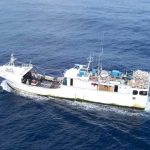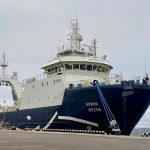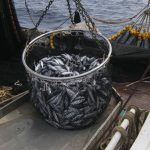Under the deal, fishermen will be allowed to continue fishing for prawns provided that they use more selective nets to reduce the capture of whitefish and adopt a range of other conservation measures, including real-time closures of fishing grounds. Whitefish fishermen will also be able to keep fishing provided they use larger mesh size nets and escape panel in the trawl.
Much of the agreement falls broadly in line with the counter-proposals put forward by the Scottish Fishermen’s Federation and the Scottish and UK Governments to fend off the original EC proposal that would have effectively closed the West coast to all fishing.
Bertie Armstrong, chief executive of the Scottish Fishermen’s Federation, whilst welcoming the continuation of fishing on the West coast, underlined that the new trawl selectivity and other conservation measures represented a real and difficult challenge for Scottish fishermen.
“We are pleased that the EC has accepted our alternative proposals to ensure the continuation of fishing on the West coast and the challenge now is to get these measures in operation and prove that they will work,” he said. “It is essential that the regulations attached to this new deal are practicable for fishermen to operate.”
The North Sea and West coast prawn quotas were cut by 5% – an improvement on the original reduction proposal, although falling well short of the Scottish and UK Governments counter-proposal of a roll-over of the 2008 quota.
Mr Armstrong said: “Unfortunately for North Sea, West coast and Irish Sea prawns the stock biology has been left behind in the political negotiation process. That is bad news for fishermen and for the prawn stock as the science is being ignored.
“One important outcome from these talks has been a change in the way that fisheries are now being managed. The Scottish industry has been at the vanguard of initiatives that ensure fishermen adopt measures to avoid catching unwanted fish in the first place, rather than the traditional control measures of tighter quotas and other restrictions, which can simply lead to discarding.
“In the North Sea, there are possible rewards in this as it gives the potential for fishermen to catch less and land more; however, the changes will present a real challenge, where additional closures and the expensive requirement to rapidly develop more selective gear will prove difficult.”
Ian Gatt, president of the Scottish Fishermen’s Federation said: “The primary goal of keeping our west coast fishing grounds open has been achieved but we should also recognise that the year ahead will be one of the most challenging ever faced by Scottish fishermen, given the very tough targets in reducing fish mortality that have been agreed.”
In practical terms, the agreement for next year means that fishermen will be able to “buy back” the number of days they are allowed to fish through the adoption of a range of whitefish avoidance measures such as area closures to fishing. The detail of how that will be achieved will be worked on during the early part of next year.
Many of the new West coast whitefish quotas have still to be finally calculated due to complicated allocation arrangements, but it is thought that the reductions of cod, haddock and whiting will be less than originally proposed. West coast monkfish was increased by 8% and megrim by 5%.
Many quotas in the North Sea had already been decided at previous talks. These included an increase in cod of 30%, with haddock down by 11%, and whiting and herring cut by 15% each. However, quota allocation arrangements may allow for more haddock and whiting to be caught. The North East Atlantic mackerel quota was increased by 33%.








